Decoding Jakarta Women’s Non-Working Travel-Mode Choice: Insights from Interpretable Machine-Learning Models
Abstract
1. Introduction
- Comprehensive analysis of the interplay between dwelling types, women’s socioeconomic characteristics, and travel motives in shaping non-work-travel-mode choices.
- XGBoost models demonstrating superior performance compared with MNL and RF models across diverse urban datasets.
- Application of SHAP analysis to interpret prediction models, revealing complex relationships influencing women’s travel-mode choices and allowing for the identification of key policy-relevant insights.
2. Data and Methodology
2.1. Study Area and Data Collection
2.2. Methodology
2.2.1. Travel-Mode-Choice Modeling Techniques
Multinomial Logit (MNL)
Extreme Gradient Boosting (XGBoost)
Random Forest (RF)
2.2.2. Evaluation Metrics for Predictive Models
2.2.3. SHAP Model Interpretation
3. Findings
3.1. To Choose, or Not to Choose, the Closest Activity Option
3.2. Evaluation and Comparison of Predictive Models for Mode Preference to Nearby and Distant Activities
3.3. Model Interpretation with Shapley Additive Explanations (SHAP)
3.3.1. SHAP Summary Plot Interpretation
3.3.2. SHAP Dependence Plot Interpretation
4. Discussion
5. Conclusions
Author Contributions
Funding
Institutional Review Board Statement
Informed Consent Statement
Data Availability Statement
Acknowledgments
Conflicts of Interest
Appendix A
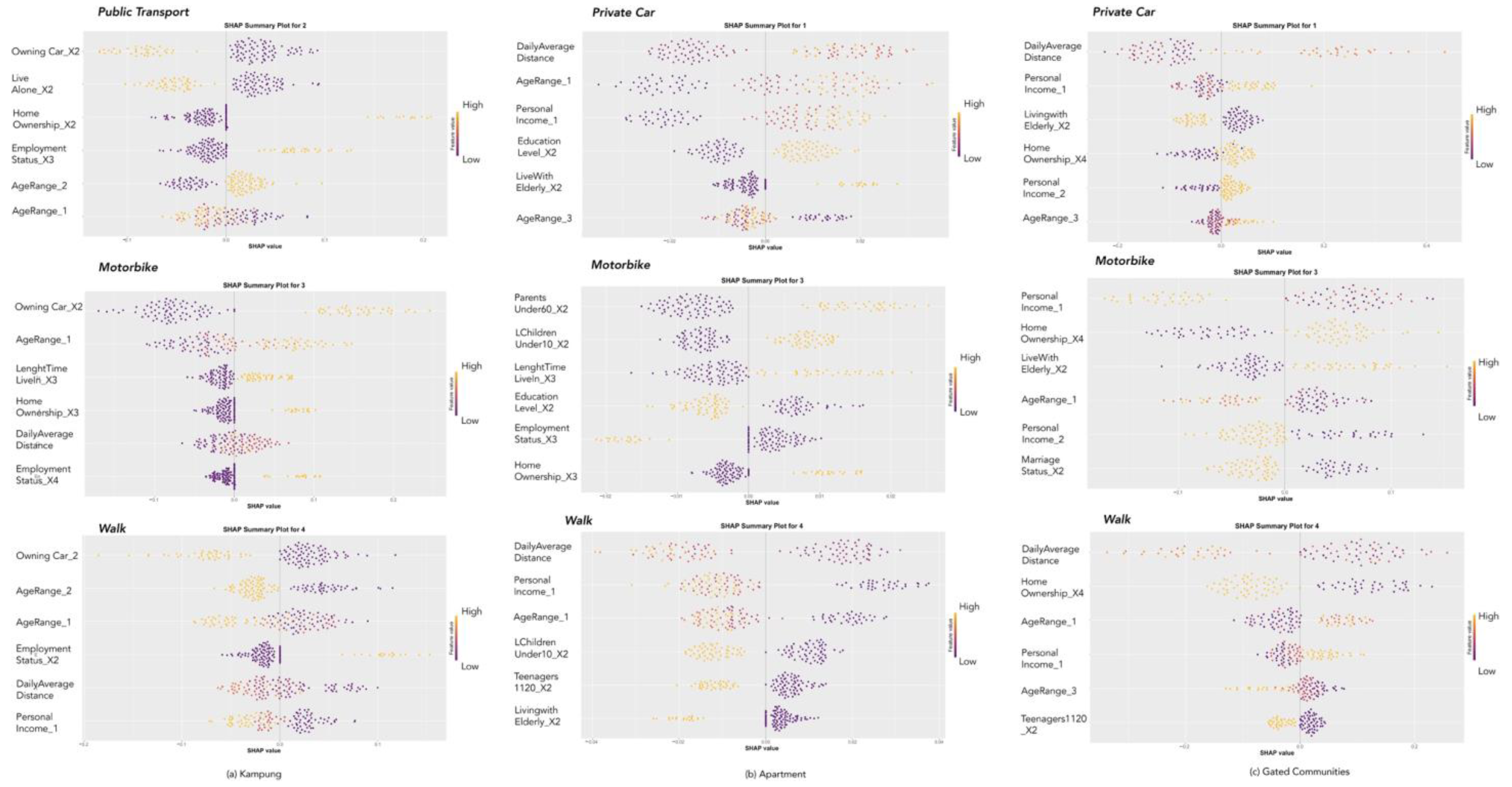
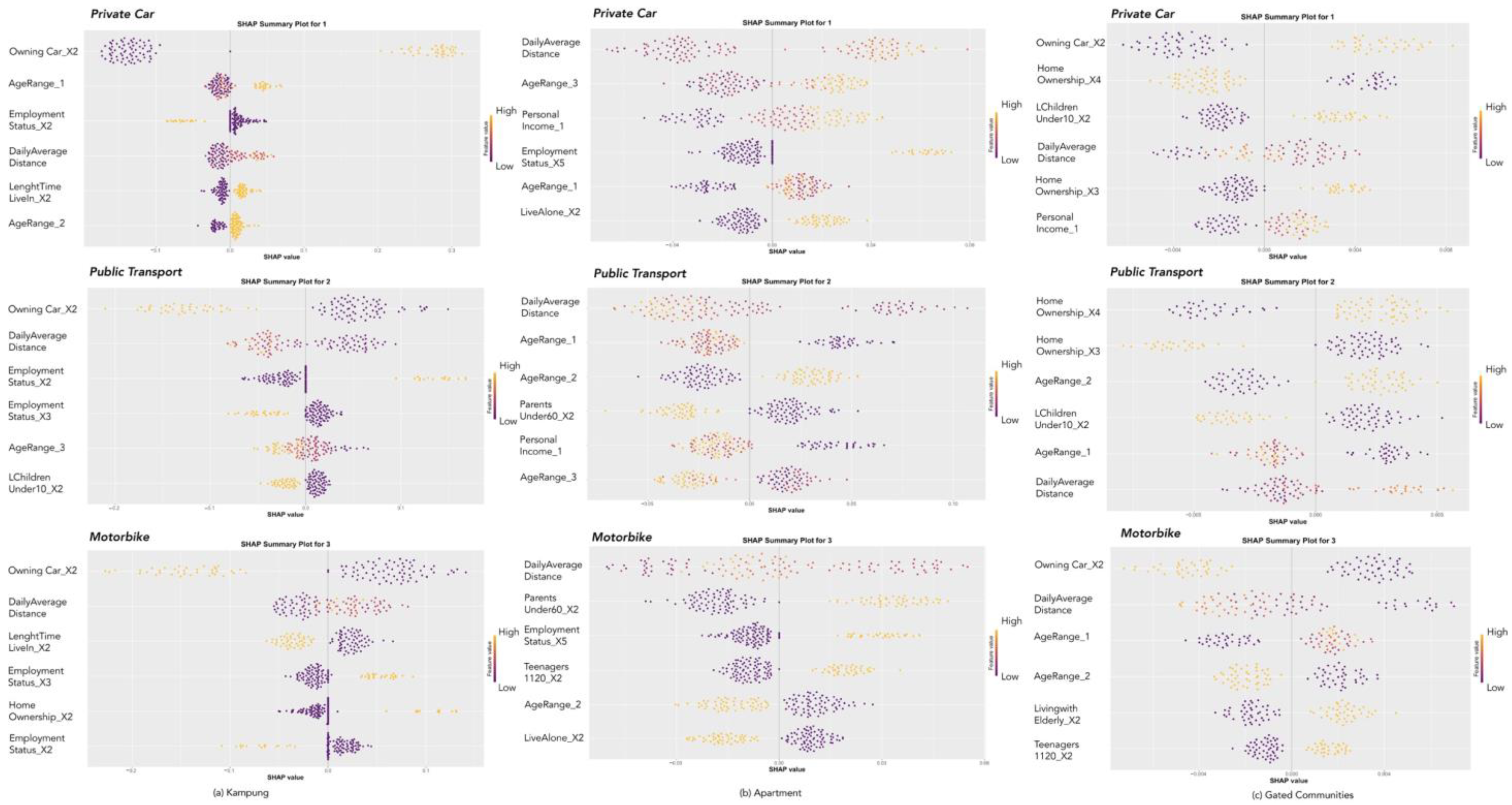



Appendix B
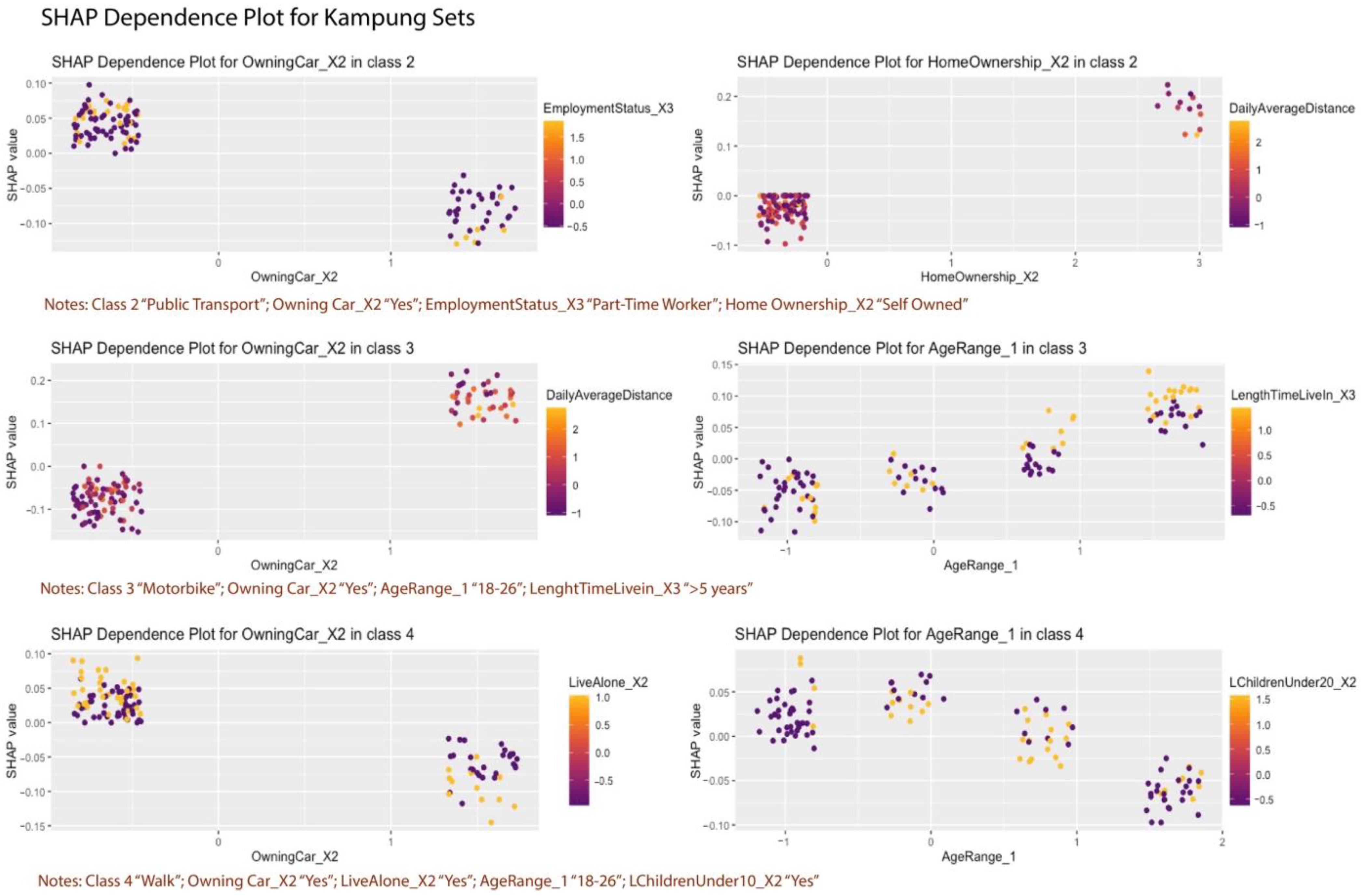

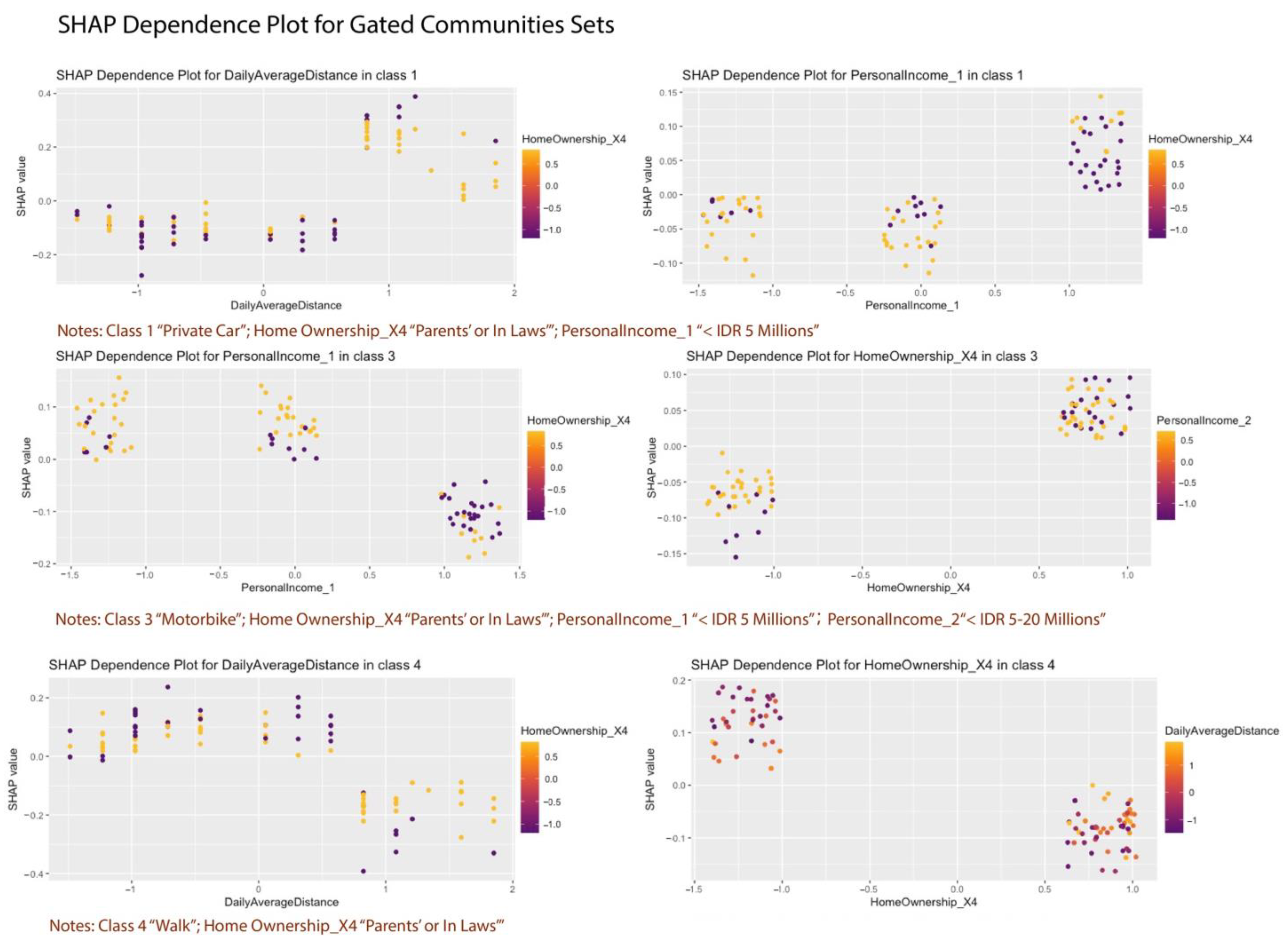

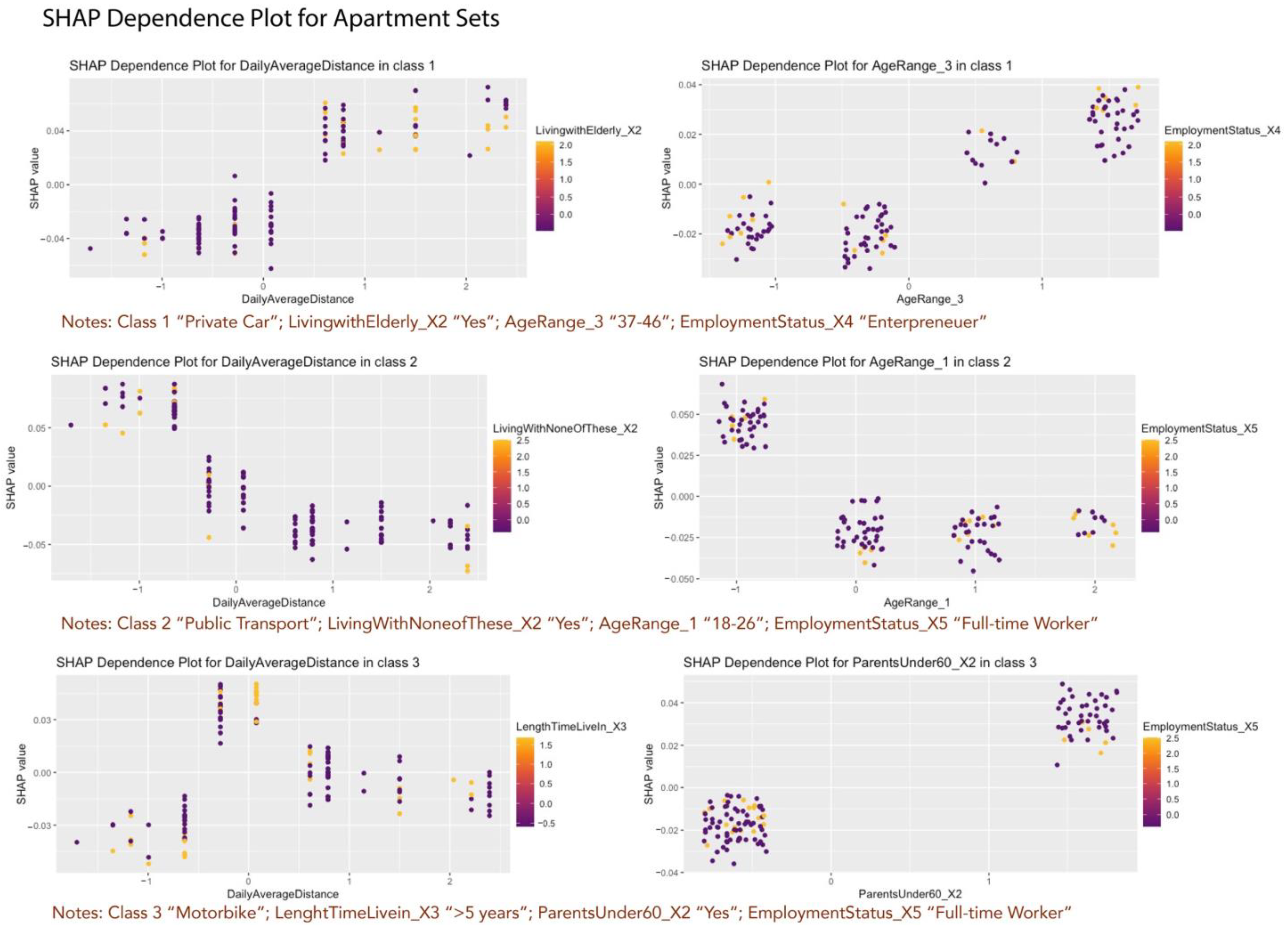
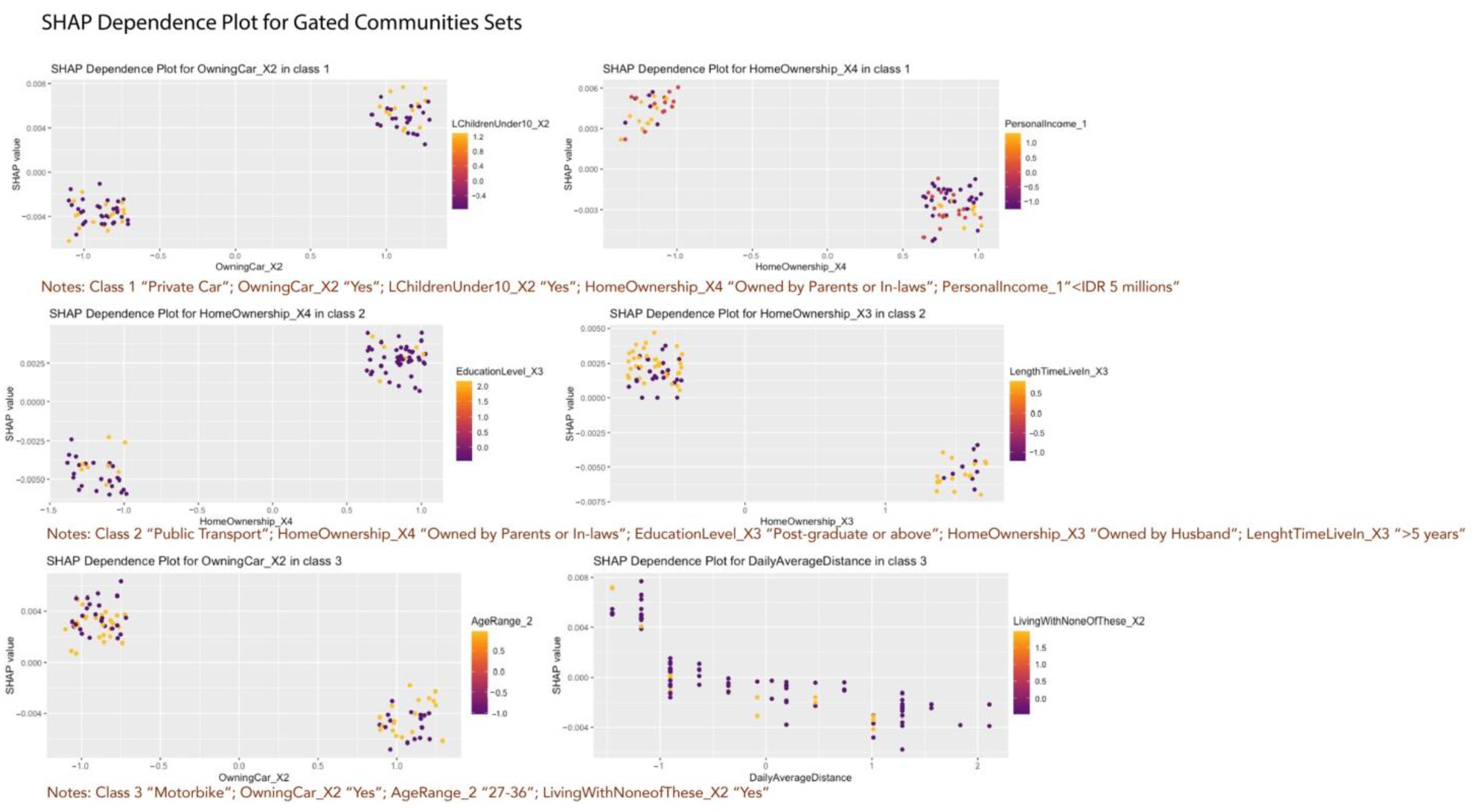
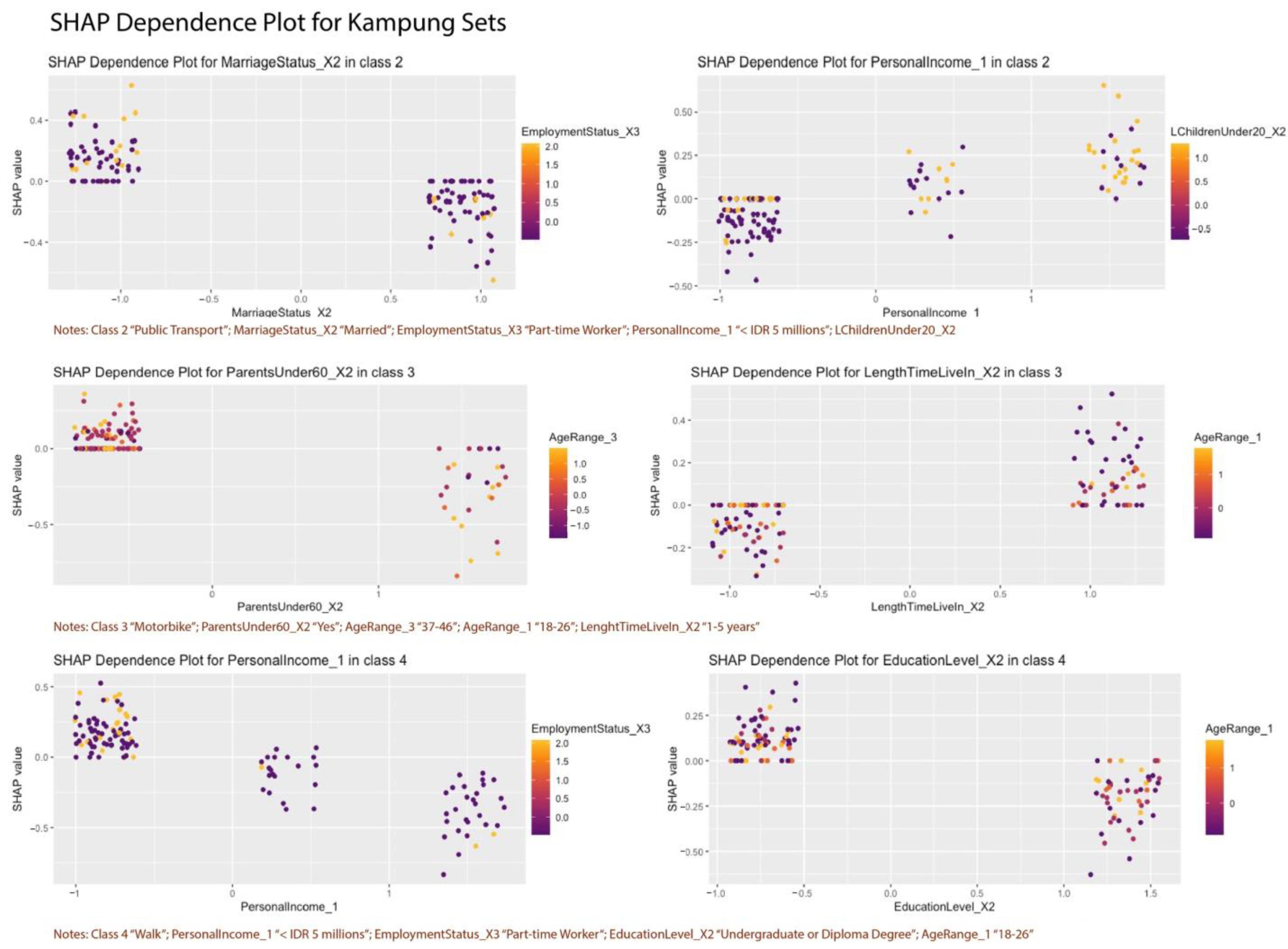



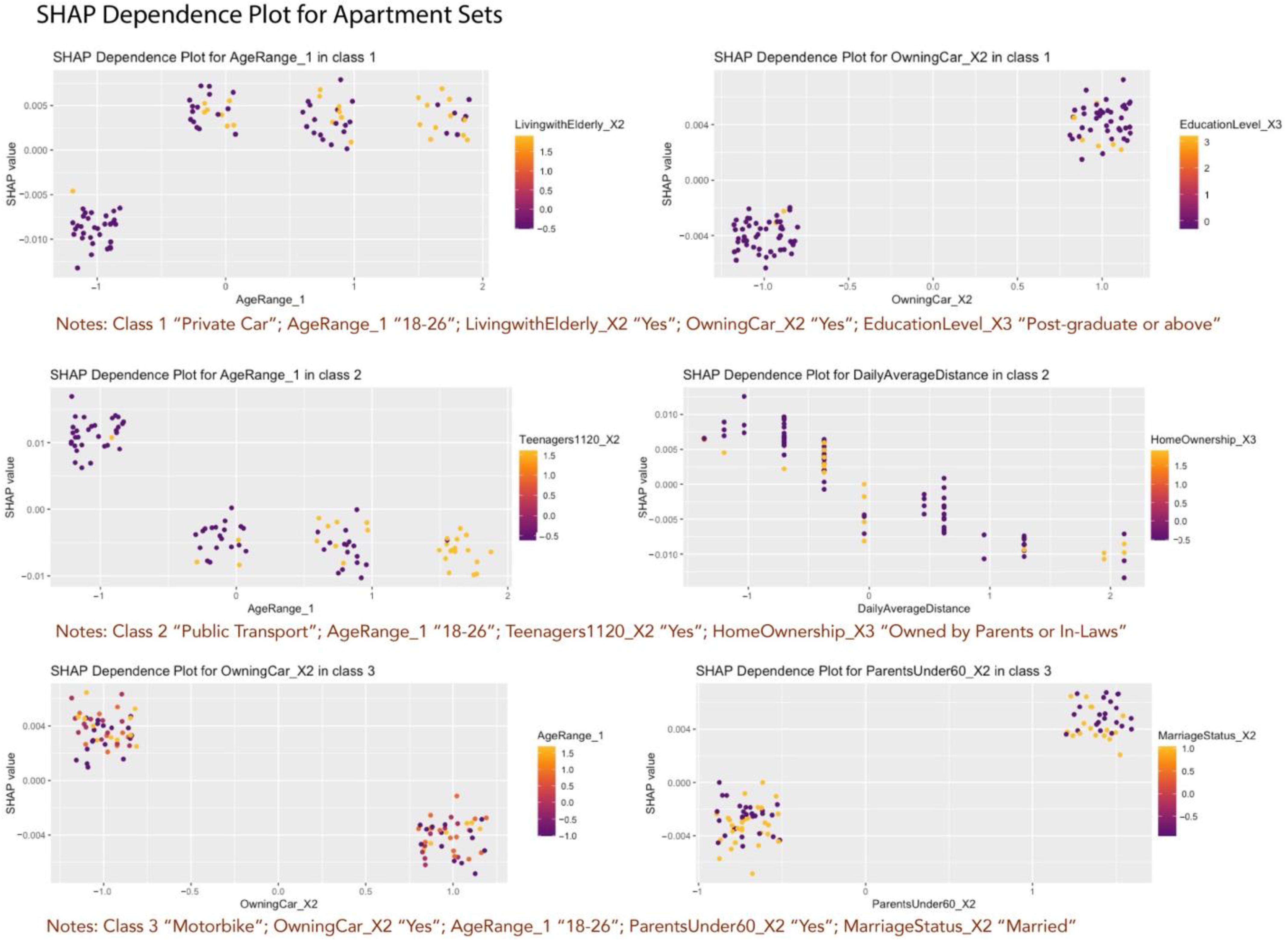

References
- Frändberg, L.; Vilhelmson, B. Spatial, Generational and Gendered Trends and Trend-Breaks in Mobility. In Handbook of Sustainable Travel; Gärling, T., Ettema, D., Friman, M., Eds.; Springer: Dordrecht, The Netherlands, 2014; pp. 15–32. ISBN 978-94-007-7033-1. [Google Scholar]
- Lo, A.W.-T.; Houston, D. How Do Compact, Accessible, and Walkable Communities Promote Gender Equality in Spatial Behavior? J. Transp. Geogr. 2018, 68, 42–54. [Google Scholar] [CrossRef]
- Chen, N.; Akar, G. Effects of Neighborhood Types & Socio-Demographics on Activity Space. J. Transp. Geogr. 2016, 54, 112–121. [Google Scholar] [CrossRef]
- McGuckin, N.; Nakamoto, Y. Differences in Trip Chaining by Men and Women. In Transportation Research Board Conference Proceedings; Transportation Research Board: Chicago, IL, USA, 2004; Volume 2, pp. 49–56. [Google Scholar]
- Chamseddine, Z.; Ait Boubkr, A. Understanding Gender, Income and Travel Behavior in Casablanca City—Morocco. Open Transp. J. 2021, 15, 272–279. [Google Scholar] [CrossRef]
- Pourhashem, G.; Malichová, E.; Piscová, T.; Kováčiková, T. Gender Difference in Perception of Value of Travel Time and Travel Mode Choice Behavior in Eight European Countries. Sustainability 2022, 14, 10426. [Google Scholar] [CrossRef]
- Ta, N.; Wang, X.; Hu, L.; Liu, Z. Gender Difference in Commuting Travel: A Comparative Study of Suburban Residents in Beijing and Shanghai. Travel Behav. Soc. 2022, 28, 196–203. [Google Scholar] [CrossRef]
- Gil Solá, A.; Vilhelmson, B. To Choose, or Not to Choose, a Nearby Activity Option: Understanding the Gendered Role of Proximity in Urban Settings. J. Transp. Geogr. 2022, 99, 103301. [Google Scholar] [CrossRef]
- Bhat, C.R.; Srinivasan, S. A Multidimensional Mixed Ordered-Response Model for Analyzing Weekend Activity Participation. Transp. Res. Part B Methodol. 2005, 39, 255–278. [Google Scholar] [CrossRef]
- Ng, W.S.; Acker, A. Understanding Urban Travel Behaviour by Gender for Efficient and Equitable Transport Policies; International Transport Forum Discussion Papers: Paris, France, 2018. [Google Scholar]
- Uteng, T.P. Gender and Mobility in The Developing World. In World Development Report 2012 Gender Equality and Development; World Bank: Washington, DC, USA, 2011. [Google Scholar]
- Gil Solá, A. Constructing Work Travel Inequalities: The Role of Household Gender Contracts. J. Transp. Geogr. 2016, 53, 32–40. [Google Scholar] [CrossRef]
- Scheiner, J.; Holz-Rau, C. Gendered Travel Mode Choice: A Focus on Car Deficient Households. J. Transp. Geogr. 2012, 24, 250–261. [Google Scholar] [CrossRef]
- Prati, G.; Fraboni, F.; De Angelis, M.; Pietrantoni, L.; Johnson, D.; Shires, J. Gender Differences in Cycling Patterns and Attitudes towards Cycling in a Sample of European Regular Cyclists. J. Transp. Geogr. 2019, 78, 1–7. [Google Scholar] [CrossRef]
- Shaw, C.; Russell, M.; Keall, M.; MacBride-Stewart, S.; Wild, K.; Reeves, D.; Bentley, R.; Woodward, A. Beyond the Bicycle: Seeing the Context of the Gender Gap in Cycling. J. Transp. Health 2020, 18, 100871. [Google Scholar] [CrossRef]
- Goel, R.; Goodman, A.; Aldred, R.; Nakamura, R.; Tatah, L.; Garcia, L.M.T.; Diomedi-Zapata, B.; de Sa, T.H.; Tiwari, G.; de Nazelle, A.; et al. Cycling Behaviour in 17 Countries across 6 Continents: Levels of Cycling, Who Cycles, for What Purpose, and How Far? Transp. Rev. 2022, 42, 58–81. [Google Scholar] [CrossRef]
- Adeel, M.; Yeh, A.G.O.; Zhang, F. Gender inequality in mobility and mode choice in Pakistan. Transportation 2017, 44, 1519–1534. [Google Scholar] [CrossRef]
- Elias, W.; Newmark, G.L.; Shiftan, Y. Gender and Travel Behavior in Two Arab Communities in Israel. Transp. Res. Rec. 2008, 2067, 75–83. [Google Scholar] [CrossRef]
- Adlakha, D.; Parra, D.C. Mind the Gap: Gender Differences in Walkability, Transportation and Physical Activity in Urban India. J. Transp. Health 2020, 18, 100875. [Google Scholar] [CrossRef]
- Cresswell, T. Gendered Mobilities; Uteng, T.P., Ed.; Routledge: London, UK, 2016; ISBN 978-1-317-12973-8. [Google Scholar]
- Haugen, K. The Advantage of ‘Near’: Which Accessibilities Matter to Whom? Eur. J. Transp. Infrastruct. Res. 2011, 11, 368–388. [Google Scholar] [CrossRef]
- Kronsell, A.; Dymén, C.; Rosqvist, L.S.; Hiselius, L.W. Masculinities and Femininities in Sustainable Transport Policy: A Focus on SWEDISH MUNICIPALITIES. Norma 2020, 15, 128–144. [Google Scholar] [CrossRef]
- Priya Uteng, T.; Turner, J. Addressing the Linkages between Gender and Transport in Low- and Middle-Income Countries. Sustainability 2019, 11, 4555. [Google Scholar] [CrossRef]
- Karjalainen, L.E.; Tiitu, M.; Lyytimäki, J.; Helminen, V.; Tapio, P.; Tuominen, A.; Vasankari, T.; Lehtimäki, J.; Paloniemi, R. Going Carless in Different Urban Fabrics: Socio-Demographics of Household Car Ownership. Transportation 2023, 50, 107–142. [Google Scholar] [CrossRef]
- Gil Solá, A.; Vilhelmson, B.; Larsson, A. Understanding Sustainable Accessibility in Urban Planning: Themes of Consensus, Themes of Tension. J. Transp. Geogr. 2018, 70, 1–10. [Google Scholar] [CrossRef]
- Law, R. Beyond ‘Women and Transport’: Towards New Geographies of Gender and Daily Mobility. Prog. Hum. Geogr. 1999, 23, 567–588. [Google Scholar] [CrossRef]
- Scholten, C.; Friberg, T.; Sandén, A. Re-Reading Time-Geography from a Gender Perspective: Examples from Gendered Mobility. Tijdschr. Voor Econ. Soc. Geogr. 2012, 103, 584–600. [Google Scholar] [CrossRef]
- Hanson, S. Gender and Mobility: New Approaches for Informing Sustainability. Gend. Place Cult. 2010, 17, 5–23. [Google Scholar] [CrossRef]
- Kronsell, A.; Smidfelt Rosqvist, L.; Winslott Hiselius, L. Achieving Climate Objectives in Transport Policy by Including Women and Challenging Gender Norms: The Swedish Case. Int. J. Sustain. Transp. 2016, 10, 703–711. [Google Scholar] [CrossRef]
- Benita, F. Exploring Non-Mandatory Travel Behavior in Jakarta City: Travel Time, Trip Frequency, and Socio-Demographic Influences. Transp. Res. Interdiscip. Perspect. 2023, 21, 100896. [Google Scholar] [CrossRef]
- Wu, L.; Wang, W.; Jing, P.; Chen, Y.; Zhan, F.; Shi, Y.; Li, T. Travel Mode Choice and Their Impacts on Environment—A Literature Review Based on Bibliometric and Content Analysis, 2000–2018. J. Clean. Prod. 2020, 249, 119391. [Google Scholar] [CrossRef]
- Næss, P.; Strand, A.; Wolday, F.; Stefansdottir, H. Residential Location, Commuting and Non-Work Travel in Two Urban Areas of Different Size and with Different Center Structures. Prog. Plan. 2019, 128, 1–36. [Google Scholar] [CrossRef]
- Olsen, J.R.; Nicholls, N.; Whitley, E.; Mitchell, R. Association between Local Amenities, Travel Behaviours and Urban Planning: A Spatial Analysis of a Nationwide UK Household Panel Study. J. Transp. Health 2024, 36, 101784. [Google Scholar] [CrossRef]
- Li, J.; Kim, C.; Sang, S. Exploring Impacts of Land Use Characteristics in Residential Neighborhood and Activity Space on Non-Work Travel Behaviors. J. Transp. Geogr. 2018, 70, 141–147. [Google Scholar] [CrossRef]
- Church, A.; Frost, M.; Sullivan, K. Transport and Social Exclusion in London. Transp. Policy 2000, 7, 195–205. [Google Scholar] [CrossRef]
- Jeekel, H. Social Exclusion, Vulnerable Groups and Driving Forces: Towards a Social Research Based Policy on Car Mobility. Case Stud. Transp. Policy 2014, 2, 96–106. [Google Scholar] [CrossRef]
- Lucas, K. Transport and Social Exclusion: Where Are We Now? Transp. Policy 2012, 20, 105–113. [Google Scholar] [CrossRef]
- Haupt, P.A.; Berghauser Pont, M.Y.; Alstäde, V.; Berg, P.G. A Systematic Review of Motives for Densification in Swedish Planning Practice. IOP Conf. Ser. Earth Environ. Sci. 2020, 588, 052030. [Google Scholar] [CrossRef]
- Rukmana, D.; Ramadhani, D. Income Inequality and Socioeconomic Segregation in Jakarta. In Urban Socio-Economic Segregation and Income Inequality; Van Ham, M., Tammaru, T., Ubarevičienė, R., Janssen, H., Eds.; The Urban Book Series; Springer International Publishing: Cham, Switzerland, 2021; pp. 135–152. ISBN 978-3-030-64568-7. [Google Scholar]
- DKI Jakarta Central Agency of Statistics. Number of Registered Motor Vehicles by Type of Motor Vehicles (Units) in DKI Jakarta Province 2020–2022; BPS-Statistics Indonesia DKI Jakarta Province: Jakarta, Indonesia, 2023. [Google Scholar]
- UN Women. Safe Cities and Safe Public Spaces Global Results Report; UN Women: New York, NY, USA, 2017; pp. 1–24. [Google Scholar]
- Tettey-Fio, E.; Kusumawardhani, N. Women’s Mobility in Jakarta: Understanding the Challenges and Opportunities. ERIA 2018, 87. [Google Scholar]
- Hidayati, I.; Tan, W.; Yamu, C. How Gender Differences and Perceptions of Safety Shape Urban Mobility in Southeast Asia. Transp. Res. Part F Traffic Psychol. Behav. 2020, 73, 155–173. [Google Scholar] [CrossRef]
- Kusumawardhani, L.P.; Kusumawati, R. Gender Inequalities and Commuting: A Study of Women’s Experience in Jakarta. Asian J. Women’s Stud. 2019, 25, 384–400. [Google Scholar]
- Bastarianto, F.; Irawan, M.; Choudhury, C.; Palma, D.; Muthohar, I. A Tour-Based Mode Choice Model for Commuters in Indonesia. Sustainability 2019, 11, 788. [Google Scholar] [CrossRef]
- San Santoso, D.; Tsunokawa, K. Spatial Transferability and Updating Analysis of Mode Choice Models in Developing Countries. Transp. Plan. Technol. 2005, 28, 341–358. [Google Scholar] [CrossRef]
- Elizandri, B.N.; Hasibuan, H.S.; Siscawati, M. The Characteristics Investigation of Women Commuters Who Participate to Use Jabodetabek Commuter Line Rail to Analyse Its Service System Quality. IOP Conf. Ser. Earth Environ. Sci. 2021, 716, 012063. [Google Scholar] [CrossRef]
- Hidayati, I.; Yamu, C.; Tan, W. The Emergence of Mobility Inequality in Greater Jakarta, Indonesia: A Socio-Spatial Analysis of Path Dependencies in Transport–Land Use Policies. Sustainability 2019, 11, 5115. [Google Scholar] [CrossRef]
- Hidayati, I.; Tan, W.; Yamu, C. Conceptualizing Mobility Inequality: Mobility and Accessibility for the Marginalized. J. Plan. Lit. 2021, 36, 492–507. [Google Scholar] [CrossRef]
- Dharmowijoyo, D.B.E.; Susilo, Y.O.; Karlström, A. Analysing the Complexity of Day-to-Day Individual Activity-Travel Patterns Using a Multidimensional Sequence Alignment Model: A Case Study in the Bandung Metropolitan Area, Indonesia. J. Transp. Geogr. 2017, 64, 1–12. [Google Scholar] [CrossRef]
- Tjahjono, T.; Kusuma, A.; Septiawan, A. The Greater Jakarta Area Commuters Travelling Pattern. Transp. Res. Procedia 2020, 47, 585–592. [Google Scholar] [CrossRef]
- Yagi, S.; Mohammadian, A. (Kouros) Joint Models of Home-Based Tour Mode and Destination Choices: Applications to a Developing Country. Transp. Res. Rec. 2008, 2076, 29–40. [Google Scholar] [CrossRef]
- Weng, M.; Ding, N.; Li, J.; Jin, X.; Xiao, H.; He, Z.; Su, S. The 15-Minute Walkable Neighborhoods: Measurement, Social Inequalities and Implications for Building Healthy Communities in Urban China. J. Transp. Health 2019, 13, 259–273. [Google Scholar] [CrossRef]
- Hagenauer, J.; Helbich, M. A Comparative Study of Machine Learning Classifiers for Modeling Travel Mode Choice. Expert Syst. Appl. 2017, 78, 273–282. [Google Scholar] [CrossRef]
- McFadden, D. Conditional Logit Analysis of Qualitative Choice Behavior; Working Paper (University of California, Berkeley. Institute of Urban & Regional Development); Institute of Urban & Regional Development: Berkeley, CA, USA, 1972. [Google Scholar]
- Bishop, C.M. Pattern Recognition and Machine Learning; Information Science and Statistics; Springer: New York, NY, USA, 2006; ISBN 978-0-387-31073-2. [Google Scholar]
- Abulibdeh, A. Analysis of Mode Choice Affects from the Introduction of Doha Metro Using Machine Learning and Statistical Analysis. Transp. Res. Interdiscip. Perspect. 2023, 20, 100852. [Google Scholar] [CrossRef]
- Cheng, L.; Chen, X.; De Vos, J.; Lai, X.; Witlox, F. Applying a Random Forest Method Approach to Model Travel Mode Choice Behavior. Travel Behav. Soc. 2019, 14, 1–10. [Google Scholar] [CrossRef]
- Wang, F.; Ross, C.L. Machine Learning Travel Mode Choices: Comparing the Performance of an Extreme Gradient Boosting Model with a Multinomial Logit Model. Transp. Res. Rec. 2018, 2672, 35–45. [Google Scholar] [CrossRef]
- Koushik, A.N.; Manoj, M.; Nezamuddin, N. Machine Learning Applications in Activity-Travel Behaviour Research: A Review. Transp. Rev. 2020, 40, 288–311. [Google Scholar] [CrossRef]
- Zhang, H.; Zhang, L.; Liu, Y.; Zhang, L. Understanding Travel Mode Choice Behavior: Influencing Factors Analysis and Prediction with Machine Learning Method. Sustainability 2023, 15, 11414. [Google Scholar] [CrossRef]
- Ullah, I.; Liu, K.; Yamamoto, T.; Zahid, M.; Jamal, A. Modeling of Machine Learning with SHAP Approach for Electric Vehicle Charging Station Choice Behavior Prediction. Travel Behav. Soc. 2023, 31, 78–92. [Google Scholar] [CrossRef]
- Lundberg, S.M.; Lee, S.-I. A Unified Approach to Interpreting Model Predictions. arXiv 2017, arXiv:1705.07874. [Google Scholar]
- Hidayati, I.; Yamu, C.; Tan, W. Realised Pedestrian Accessibility of an Informal Settlement in Jakarta, Indonesia. J. Urban. Int. Res. Placemak. Urban Sustain. 2021, 14, 434–456. [Google Scholar] [CrossRef]
- Martinez, R.; Masron, I.N. Jakarta: A City of Cities. Cities 2020, 106, 102868. [Google Scholar] [CrossRef]
- BPS-Statistics DKI Jakarta Province. DKI Jakarta Province in Infographics 2023; BPS-Statistics DKI Jakarta Province: Jakarta, Indonesia, 2024; p. 86.
- Alzamil, W. The Urban Features of Informal Settlements in Jakarta, Indonesia. Data Brief 2017, 15, 993–999. [Google Scholar] [CrossRef]
- Hutama, I.A.W. Exploring the Sense of Place of an Urban Kampung: Through the Daily Activities, Configuration of Space and Dweller’s Perception: Case Study of Kampung Code, Yogyakarta. Master’s Thesis, University of Twente, Enschede, The Netherlands, 2016. [Google Scholar]
- BPS-Statistics South Jakarta City. Jakarta Selatan Municipality in Figures 2021; BPS-Statistics South Jakarta City: Jakarta, Indonesia, 2021; p. 74. [Google Scholar]
- JLL. Jakarta Property Market Review 4Q 2020; JLL Indonesia: Jakarta, Indonesia, 2021; pp. 1–16. [Google Scholar]
- Hapsariniaty, A.W.; Sidi, B.D.; Nurdini, A. Comparative Analysis of Choosing to Live in Gated Communities: A Case Study of Bandung Metropolitan Area. Procedia-Soc. Behav. Sci. 2013, 101, 394–403. [Google Scholar] [CrossRef][Green Version]
- Salas, P.; De La Fuente, R.; Astroza, S.; Carrasco, J.A. A Systematic Comparative Evaluation of Machine Learning Classifiers and Discrete Choice Models for Travel Mode Choice in the Presence of Response Heterogeneity. Expert Syst. Appl. 2022, 193, 116253. [Google Scholar] [CrossRef]
- Sekhar, C.R. Mode Choice Analysis: The Data, the Models and Future Ahead. Int. J. Traffic Transp. Eng. 2014, 4, 269–285. [Google Scholar] [CrossRef]
- Pineda-Jaramillo, J.D. A Review of Machine Learning (ML) Algorithms Used for Modeling Travel Mode Choice. Dyna 2019, 86, 32–41. [Google Scholar] [CrossRef]
- Dahmen, V.; Weikl, S.; Bogenberger, K. Interpretable Machine Learning for Mode Choice Modeling on Tracking-Based Revealed Preference Data. Transp. Res. Rec. J. Transp. Res. Board 2024. [CrossRef]
- Chen, T.; Guestrin, C. XGBoost: A Scalable Tree Boosting System. In Proceedings of the 22nd ACM SIGKDD International Conference on Knowledge Discovery and Data Mining, San Francisco, CA, USA, 13–17 August 2016; Association for Computing Machinery: New York, NY, USA, 2016; pp. 785–794. [Google Scholar]
- Yang, X.; Zhang, J.; Wang, K.; Feng, C.; Li, J. Prediction of Resident Travel Modes Based on XGBoost and Analysis of Behavioral Interaction Characteristics. arXiv 2023. [Google Scholar] [CrossRef]
- Chen, H.; Cheng, Y. Travel Mode Choice Prediction Using Imbalanced Machine Learning. IEEE Trans. Intell. Transp. Syst. 2023, 24, 3795–3808. [Google Scholar] [CrossRef]
- Liang, W.; Luo, S.; Zhao, G.; Wu, H. Predicting Hard Rock Pillar Stability Using GBDT, XGBoost, and LightGBM Algorithms. Mathematics 2020, 8, 765. [Google Scholar] [CrossRef]
- Breiman, L. Random Forests. Mach. Learn. 2001, 45, 5–32. [Google Scholar] [CrossRef]
- Yang, W.; Zhou, S. Using Decision Tree Analysis to Identify the Determinants of Residents’ CO2 Emissions from Different Types of Trips: A Case Study of Guangzhou, China. J. Clean. Prod. 2020, 277, 124071. [Google Scholar] [CrossRef]
- Lundberg, S.M.; Erion, G.; Chen, H.; DeGrave, A.; Prutkin, J.M.; Nair, B.; Katz, R.; Himmelfarb, J.; Bansal, N.; Lee, S.-I. From Local Explanations to Global Understanding with Explainable AI for Trees. Nat. Mach. Intell. 2020, 2, 56–67. [Google Scholar] [CrossRef]
- Ji, S.; Wang, X.; Lyu, T.; Liu, X.; Wang, Y.; Heinen, E.; Sun, Z. Understanding Cycling Distance According to the Prediction of the XGBoost and the Interpretation of SHAP: A Non-Linear and Interaction Effect Analysis. J. Transp. Geogr. 2022, 103, 103414. [Google Scholar] [CrossRef]
- Dorosan, M.; Dailisan, D.; Valenzuela, J.F.; Monterola, C. Use of Machine Learning in Understanding Transport Dynamics of Land Use and Public Transportation in a Developing City. Cities 2024, 144, 104587. [Google Scholar] [CrossRef]
- Mouratidis, K. Built Environment and Leisure Satisfaction: The Role of Commute Time, Social Interaction, and Active Travel. J. Transp. Geogr. 2019, 80, 102491. [Google Scholar] [CrossRef]
- Gul, Y.; Sultan, Z.; Johar, F. Effects of Neighborhood’s Built Environment on Physical Activities in Gated Communities: A Review. Int. J. BES 2016, 3, 60–69. [Google Scholar] [CrossRef]
- Bruntlett, M. The 15-Minute City: A Feminist Utopia? Transformative Urban Mobility Initiative: Bonn, Germany, 2022. [Google Scholar]
- Murray, S.D.; Jin, H.S.; Martin, B.A.S. The Role of Shopping Orientation in Variety-Seeking Behaviour. J. Bus. Res. 2022, 145, 188–197. [Google Scholar] [CrossRef]
- Olivieri, C.; Fageda, X. Urban Mobility with a Focus on Gender: The Case of a Middle-Income Latin American City. J. Transp. Geogr. 2021, 91, 102996. [Google Scholar] [CrossRef]
- Van Den Berg, P.; Larosi, H.; Maussen, S.; Arentze, T. Sense of Place, Shopping Area Evaluation, and Shopping Behaviour. Geogr. Res. 2021, 59, 584–598. [Google Scholar] [CrossRef]
- Dhuria, P.; Lawrence, W.; Crozier, S.; Cooper, C.; Baird, J.; Vogel, C. Women’s Perceptions of Factors Influencing Their Food Shopping Choices and How Supermarkets can Support Them to Make Healthier Choices. BMC Public Health 2021, 21, 1070. [Google Scholar] [CrossRef] [PubMed]
- Indrasari, F. Exploring Automobile Dependency of Housing Estate Residents and Kampung Dwellers in Suburban Bandung, Indonesia. In Proceedings of the 55th World Planning Congress in Jakarta, Bogor, Indonesia, 9–13 September 2021. [Google Scholar] [CrossRef]
- Lagrell, E.; Gil Solá, A. Car Use of the Carless in Sweden: Everyday Life Conditions for Reducing Car Dependence. Sustainability 2021, 13, 10250. [Google Scholar] [CrossRef]
- Li, W.; Kockelman, K.M. How Does Machine Learning Compare to Conventional Econometrics for Transport Data Sets? A Test of ML versus MLE. Growth Chang. 2022, 53, 342–376. [Google Scholar] [CrossRef]
- Bentéjac, C.; Csörgő, A.; Martínez-Muñoz, G. A Comparative Analysis of XGBoost. Artif. Intell. Rev. 2021, 54, 1937–1967. [Google Scholar] [CrossRef]
- Bhuiya, M.M.R.; Hasan, M.M.U.; Keellings, D.J.; Mohiuddin, H. Application of Machine Learning Classifiers for Mode Choice Modeling for Movement-Challenged Persons. Future Transp. 2022, 2, 328–346. [Google Scholar] [CrossRef]
- Asad, S.M.; Dashtipour, K.; Rais, R.N.B.; Hussain, S.; Abbasi, Q.H.; Imran, M.A. Employing Machine Learning for Predicting Transportation Modes Under the COVID-19 Pandemic: A Mobility-Trends Analysis. In Proceedings of the 2021 International Conference on UK-China Emerging Technologies (UCET), Chengdu, China, 4–6 November 2021; pp. 235–240. [Google Scholar]
- Yang, H.-C.; Jin, L.; Lazar, A.; Todd-Blick, A.; Sim, A.; Wu, K.; Chen, Q.; Spurlock, C.A. Gender Gaps in Mode Usage, Vehicle Ownership, and Spatial Mobility When Entering Parenthood: A Life Course Perspective. Systems 2023, 11, 314. [Google Scholar] [CrossRef]
- Unbehaun, W.; Uhlmann, T.; Hoessinger, R.; Leisch, F.; Gerike, R. Women and Men With Care Responsibilities in the Austrian Alps Activity and Mobility Patterns of a Diverse Group. Mt. Res. Dev. 2014, 34, 276–290. [Google Scholar] [CrossRef]
- Acker, V.V.; Mokhtarian, P.L.; Witlox, F. Going Soft: On How Subjective Variables Explain Modal Choices for Leisure Travel. Eur. J. Transp. Infrastruct. Res. 2011, 11, 115–146. [Google Scholar] [CrossRef]
- Irawan, M.Z.; Belgiawan, P.F.; Tarigan, A.K.M.; Wijanarko, F. To Compete or Not Compete: Exploring the Relationships between Motorcycle-Based Ride-Sourcing, Motorcycle Taxis, and Public Transport in the Jakarta Metropolitan Area. Transportation 2020, 47, 2367–2389. [Google Scholar] [CrossRef]
- Joewono, T.B.; Wirayat, M.Y.F.; Belgiawan, P.F.; Andani, I.G.A.; Gunawijaya, C. Users’ Preferences in Selecting Transportation Modes for Leisure Trips in the Digital Era: Evidence from Bandung, Indonesia. Sustainability 2023, 15, 2503. [Google Scholar] [CrossRef]
- Ghimire, S.; Bardaka, E. Active Travel among Carless and Car-Owning Low-Income Populations in the United States. Transp. Res. Part D Transp. Environ. 2023, 117, 103627. [Google Scholar] [CrossRef]
- Etminani-Ghasrodashti, R.; Ardeshiri, M. Modeling Travel Behavior by the Structural Relationships between Lifestyle, Built Environment and Non-Working Trips. Transp. Res. Part A Policy Pract. 2015, 78, 506–518. [Google Scholar] [CrossRef]
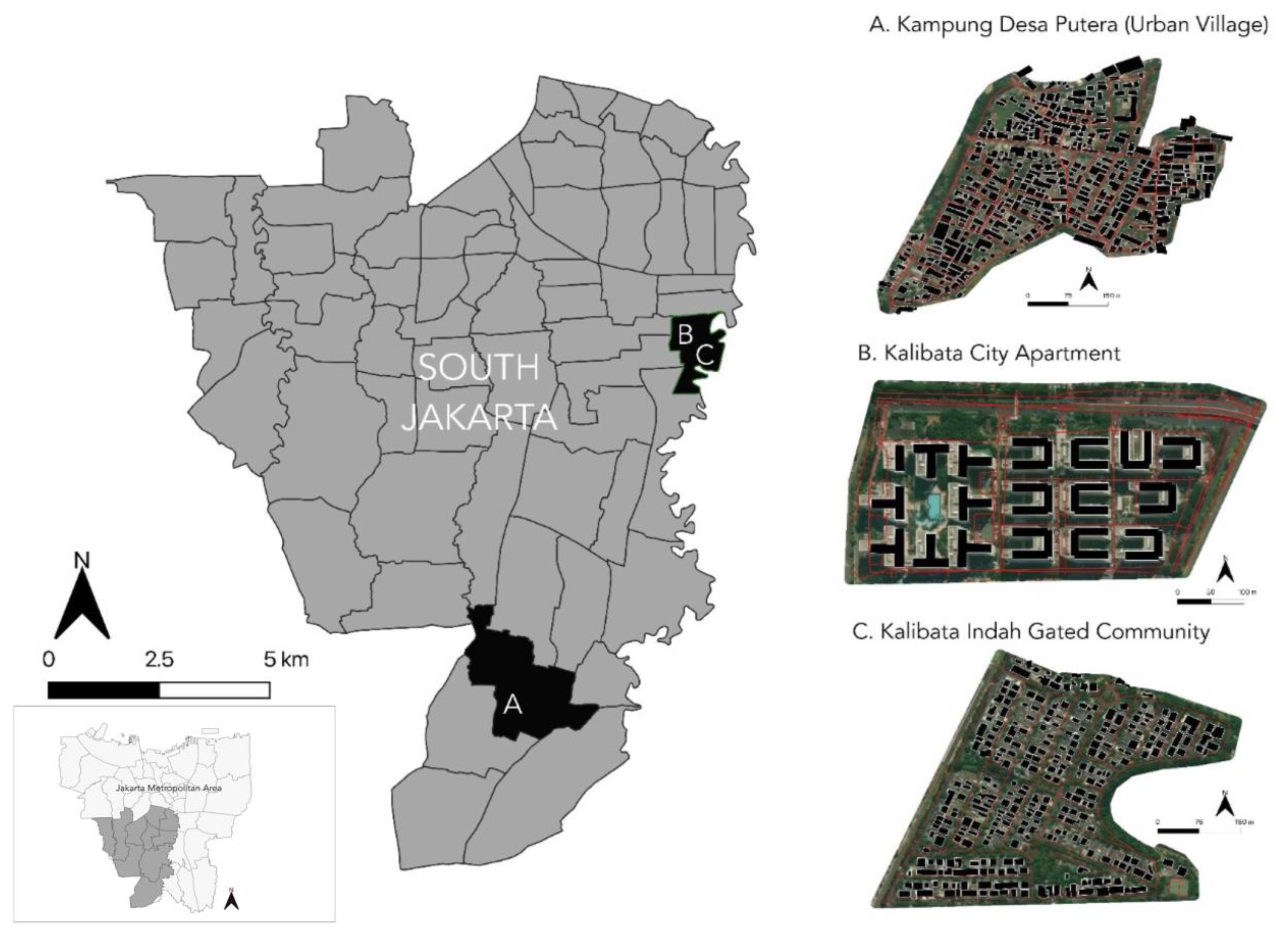
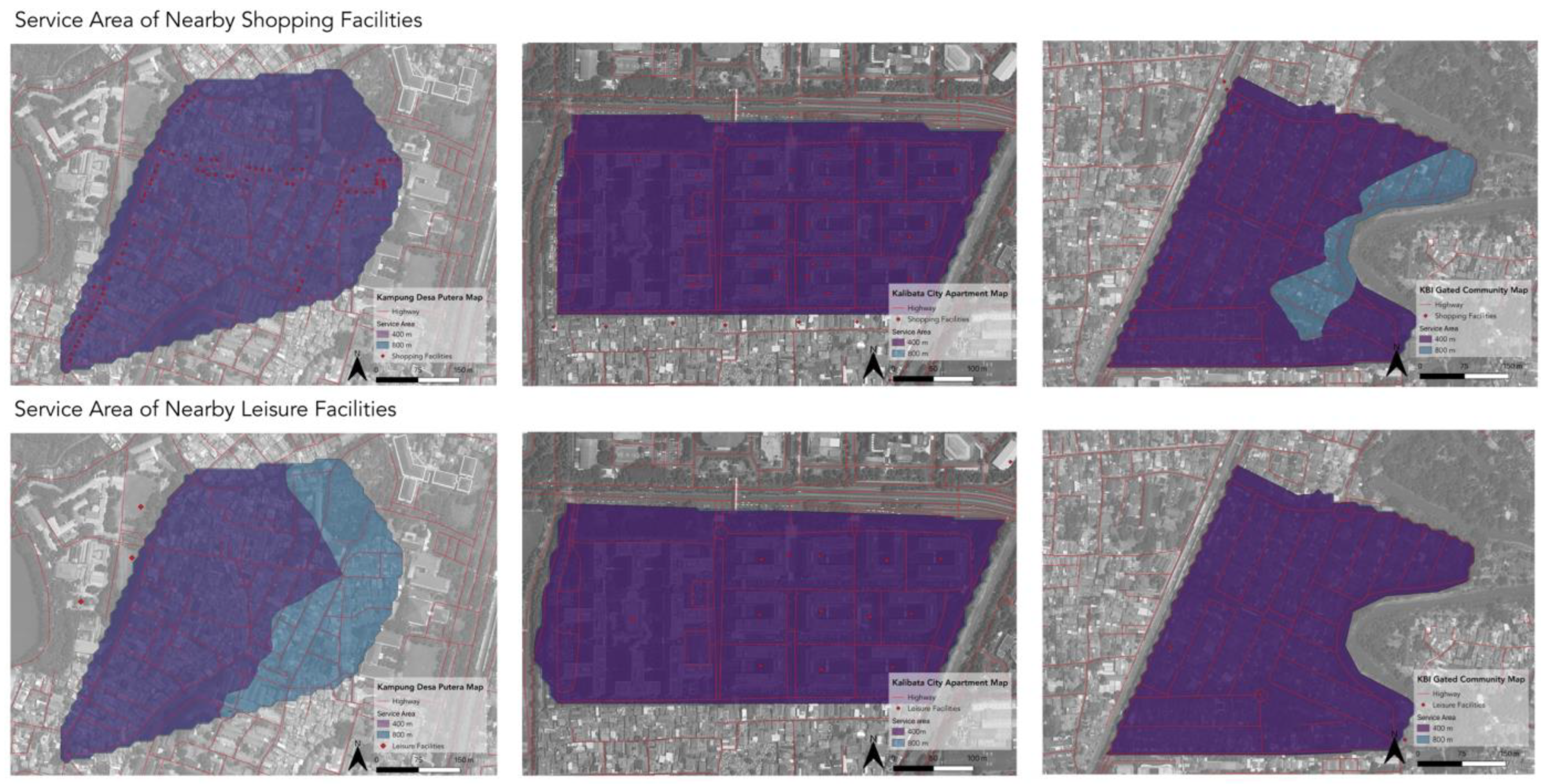
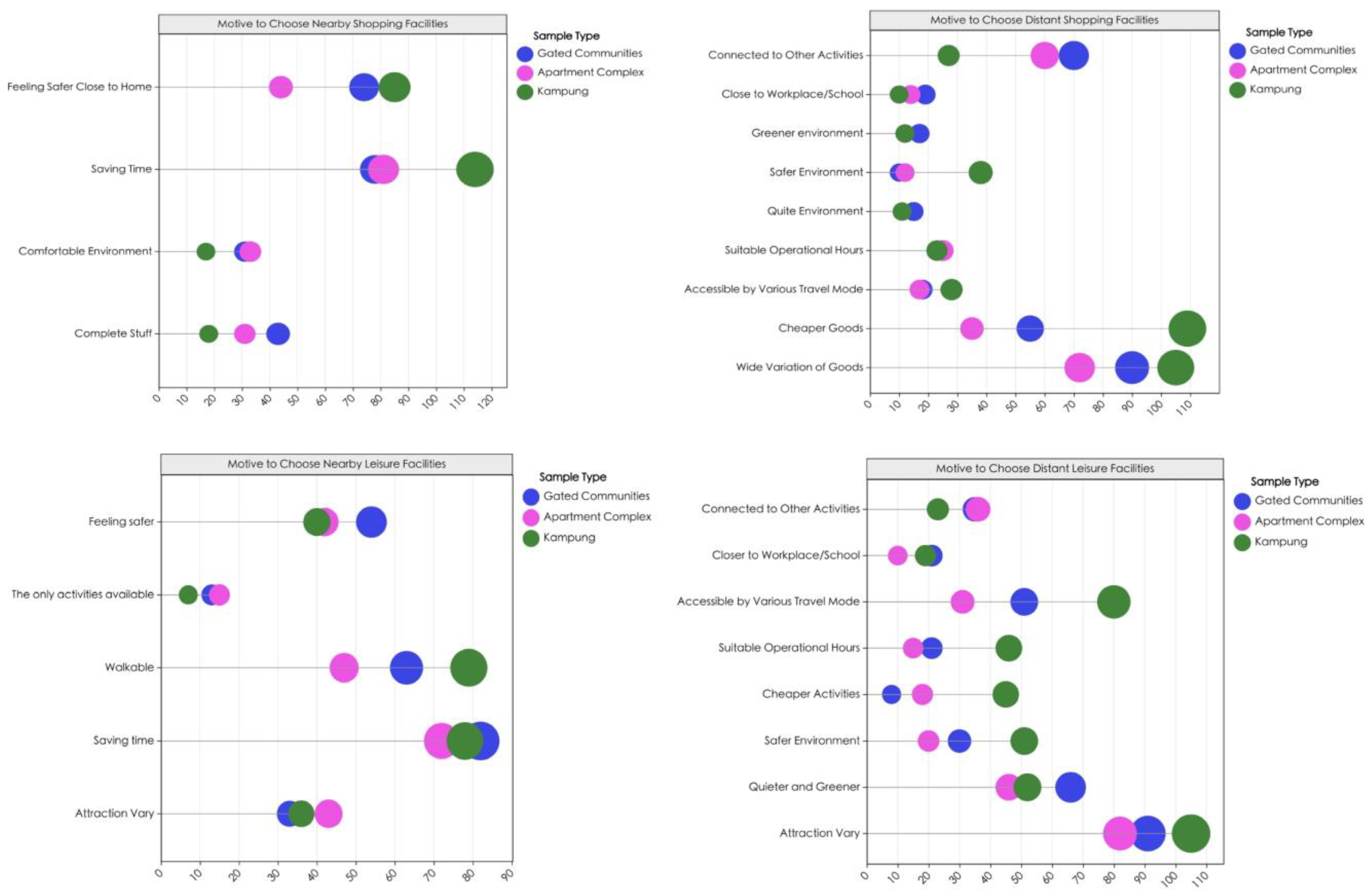
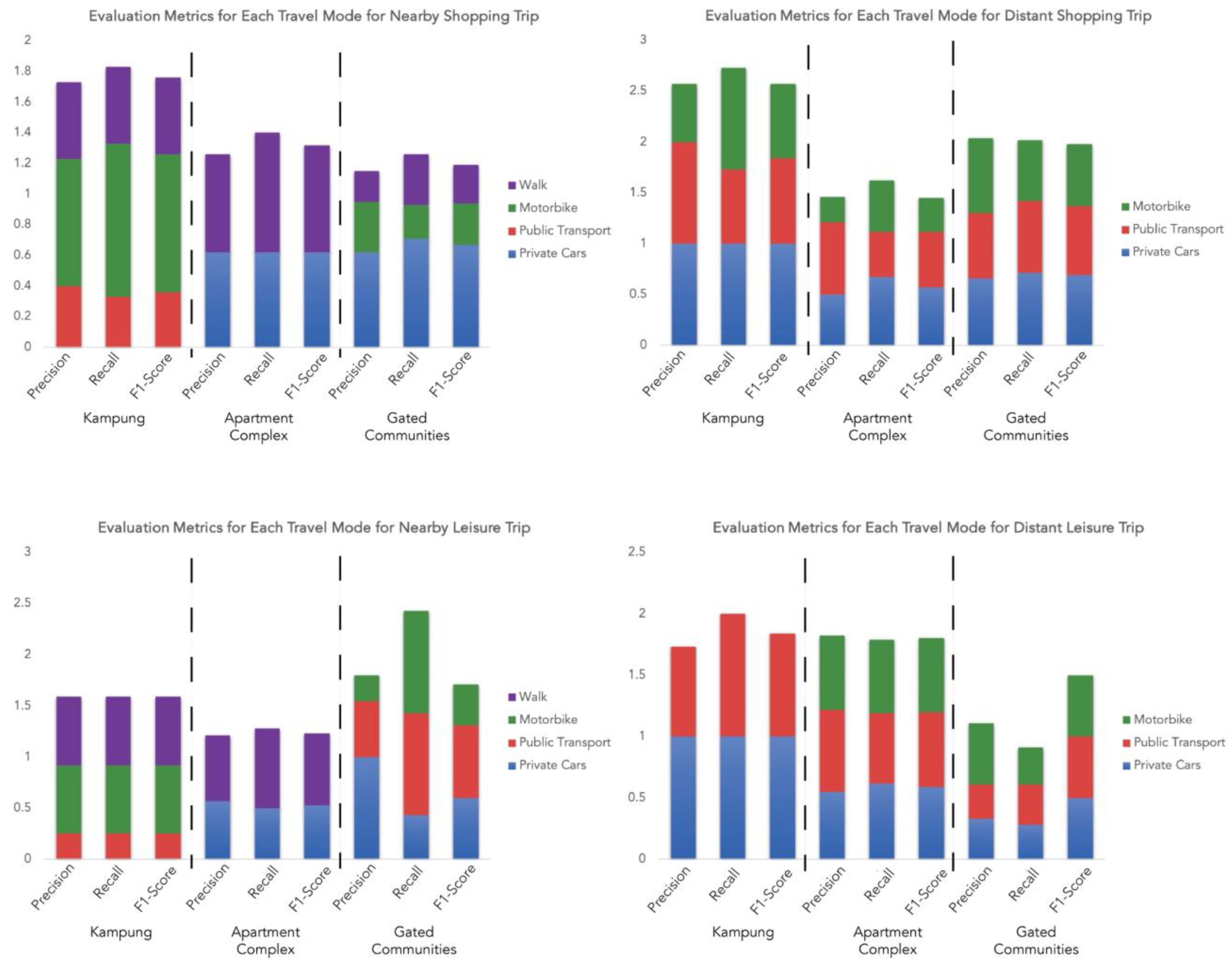
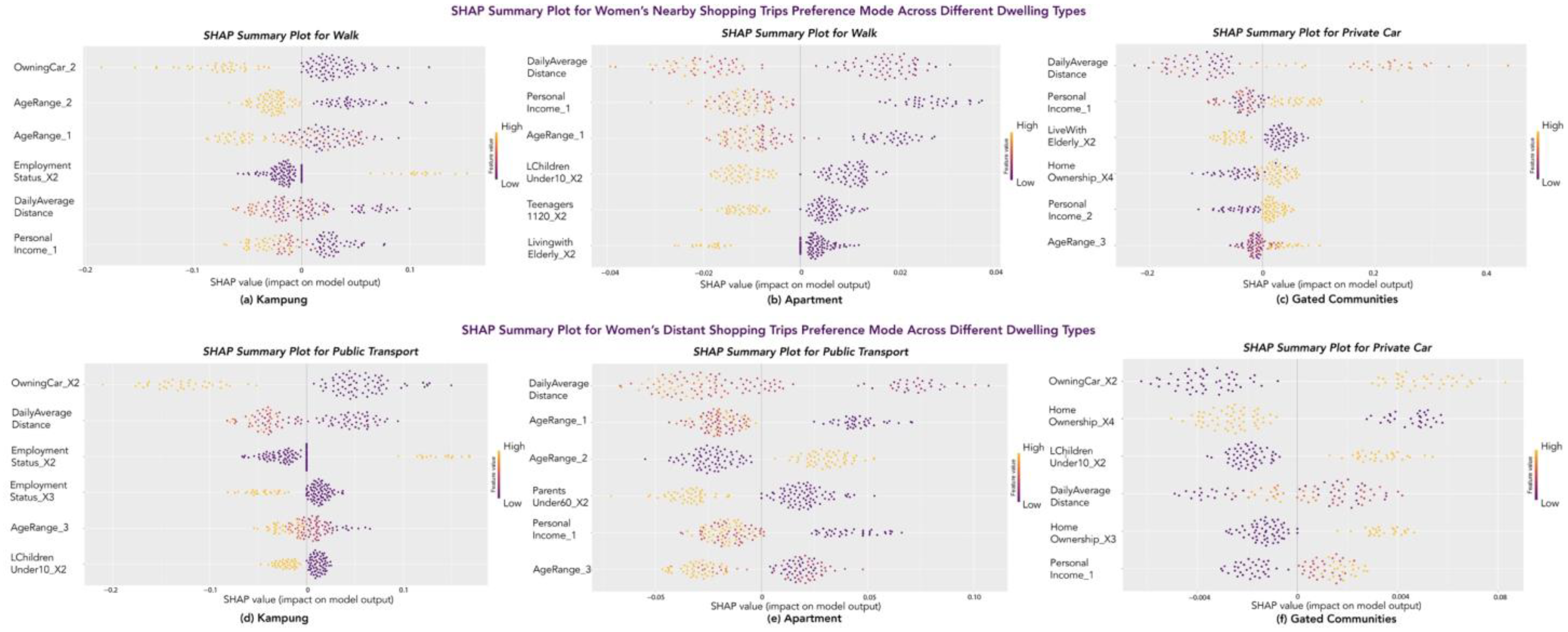
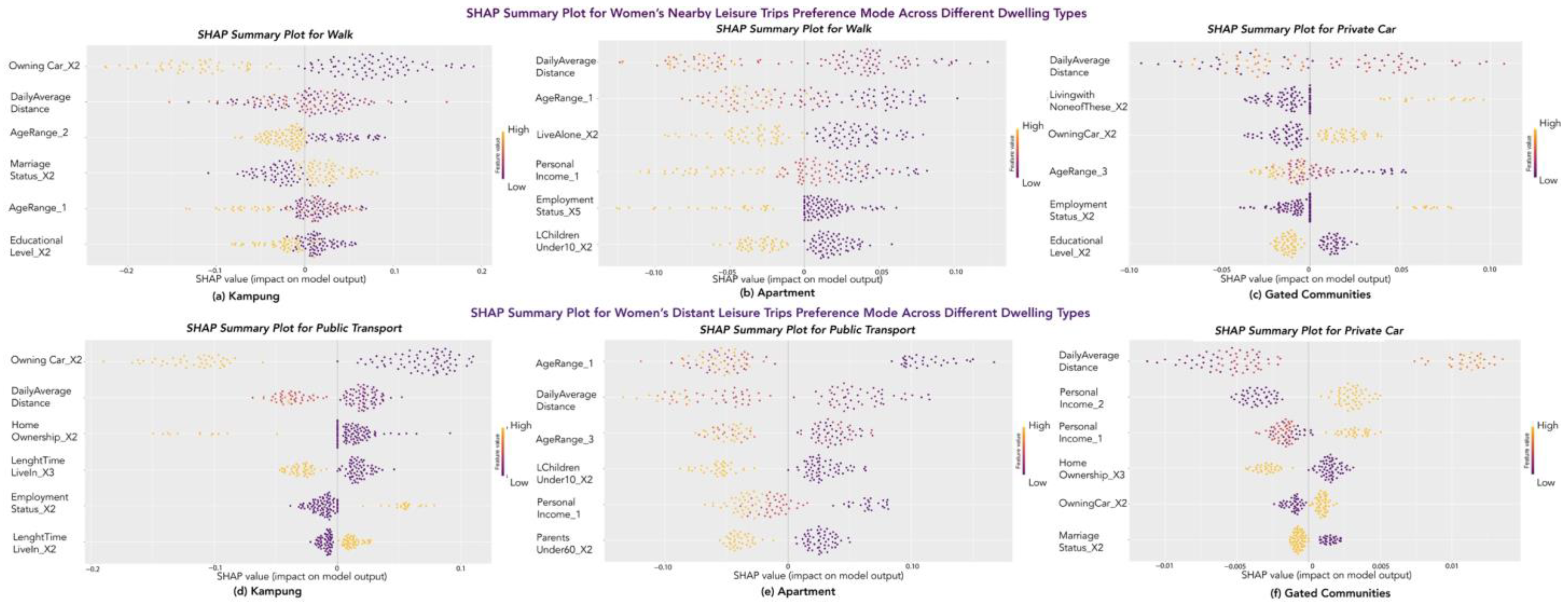


| Variable | Study Area Sample + | |||
|---|---|---|---|---|
| Kampung | Apartment Complex | Gated Community | ||
| (n = 117) | (n = 117) | (n = 109) | ||
| Age range (Year) | 18–26 | 43.59% | 40.17% | 40.37% |
| 27–36 | 23.93% | 25.64% | 23.85% | |
| 37–46 | 17.95% | 19.66% | 19.27% | |
| 47–56 | 14.53% | 14.53% | 16.51% | |
| 0.594 c | ||||
| Marriage status | Single | 42.74% | 52.99% | 38.53% |
| Married | 57.26% | 47.01% | 61.47% | |
| 5.105 c | ||||
| Education level | High school or below | 53.85% | 34.19% | 34.86% |
| Undergraduate or diploma | 37.61% | 57.26% | 47.71% | |
| Postgraduate | 8.55% | 8.55% | 17.43% | |
| 16.936 ** c | ||||
| Length time lived in neighborhood (years) | <1 | 20.51% | 24.79% | 4.59% |
| 1–5 | 47.86% | 49.57% | 33.94% | |
| >5 | 31.62% | 25.64% | 61.47% | |
| 39.762 ** c | ||||
| Rent | 64.10% | 52.99% | 8.26% | |
| Home ownership | Self-owned | 8.55% | 11.97% | 7.34% |
| Owned by husband | 9.40% | 19.66% | 24.77% | |
| Owned by parents/in-laws | 17.95% | 15.38% | 59.63% | |
| 100.539 ** c | ||||
| Employment status | Unemployed | 36.75% | 16.24% | 15.60% |
| Student | 19.66% | 23.93% | 14.68% | |
| Part-time worker | 23.08% | 18.80% | 11.93% | |
| Entrepreneur | 12.82% | 20.51% | 16.51% | |
| Full-time worker | 7.69% | 20.51% | 41.28% | |
| 51.404 ** c | ||||
| Personal income (IDR) | <5,000,000 | 55.56% | 35.04% | 28.44% |
| 5,000,000–20,000,000 | 21.37% | 38.46% | 38.53% | |
| >20,000,000 | 23.08% | 26.50% | 33.03% | |
| 20.473 ** c | ||||
| Living with elderly | 30.77% | 18.80% | 33.03% | |
| 6.749 * c | ||||
| Having children under 10 | 29.91% | 35.90% | 36.70% | |
| 1.407 c | ||||
| Living with teenage students (11–20) | 68.38% | 24.79% | 38.53% | |
| 47.061 ** c | ||||
| Living with parents under 60 | 29.91% | 30.77% | 22.02% | |
| 2.594 c | ||||
| Living alone | 46.15% | 33.33% | 3.67% | |
| 52.451 ** c | ||||
| None of the above | 9.40% | 13.68% | 22.94% | |
| 8.341 * c | ||||
| Owning a car | 28.21% | 47.01% | 44.95% | |
| 10.296 ** c | ||||
| Variable | Study Area Sample + | |||
|---|---|---|---|---|
| Kampung | Apartment Complex | Gated Community | ||
| (n = 117) | (n = 117) | (n = 109) | ||
| Daily commuting distance (km) | 13.76 # | 11.95 # | 15.6 # | |
| One-way ANOVA by study area | 0.002 ** | |||
| Commuting modes to the nearest shop | Private car | 0.00% | 35.04% | 40.37% |
| Public transport | 26.50% | 0.00% | 0.00% | |
| Motorbike | 25.64% | 18.80% | 34.86% | |
| Walk | 47.86% | 46.15% | 24.77% | |
| 119.35 ** c | ||||
| Commuting modes to the distant shop | Private car | 28.21% | 25.64% | 36.70% |
| Public transport | 44.44% | 52.14% | 32.11% | |
| Motorbike | 27.35% | 22.22% | 31.19% | |
| Walk | 0.00% | 0.00% | 0.00% | |
| 9.519 * c | ||||
| Commuting modes to the nearest leisure facilities | Private car | 0.00% | 33.33% | 30.28% |
| Public transport | 24.79% | 0.00% | 20.18% | |
| Motorbike | 23.08% | 18.80% | 21.10% | |
| Walk | 52.14% | 47.86% | 28.44% | |
| 73.5 ** c | ||||
| Commuting modes to distant leisure facilities | Private car | 27.35% | 35.90% | 41.28% |
| Public transport | 46.15% | 40.17% | 33.94% | |
| Motorbike | 26.50% | 23.93% | 24.77% | |
| Walk | 0.00% | 0.00% | 0.00% | |
| 5.482 c | ||||
| Residence distance from the city center (km) | 17 | 8 | 9 | |
| Variables | Numeric Value | Type |
|---|---|---|
| Age range | 1—18–26; 2—27–36; 3—37–46; 4—47–56 | Ordinal |
| Marriage status | 1—single; 2—married | Nominal |
| Educational level | 1—high school or below; 2—undergraduate or diploma; 3—postgraduate | Nominal |
| Length time lived in neighborhood (years) | 1—<1; 2—1–5; 3—>5 | Nominal |
| Home ownership | 1—rent; 2—self-owned; 3—owned by husband; 4—owned by Parents/In-Law | Nominal |
| Employment status | 1—unemployed; 2—student; 3—part-time worker; 4—entrepreneur; 5—full-time worker | Nominal |
| Personal income (IDR) | 1—<5,000,000; 2—5,000,000–20,000,000; 3—>20,000,000 | Ordinal |
| Living with elderly | 1—No; 2—Yes | Nominal |
| Having children under 10 | 1—No; 2—Yes | Nominal |
| Living with teenage students (11–20) | 1—No; 2—Yes | Nominal |
| Living with parents under 60 | 1—No; 2—Yes | Nominal |
| Living alone | 1—No; 2—Yes | Nominal |
| None of the above | 1—No; 2—Yes | Nominal |
| Owning a car | 1—No; 2—Yes | Nominal |
| Daily commuting distance (km) | Actual value | Numeric |
| Commuting modes | 1—private car; 2—public transport; 3—motorbike; 4—walk | Nominal |
| Predicted Class | ||||
|---|---|---|---|---|
| Actual Class | Class 1 | Class 2 | Class 3 | |
| Class 1 | TP1 | FP12 | FP13 | |
| Class 2 | FN21 | TP2 | FP23 | |
| Class 3 | FN31 | FN32 | TP3 | |
| Preference Mode to Nearby Shopping Facilities | ||||||||
| Residential Type | Models | Hyperparameters | Accuracy | Precision | Recall | F1-Score | MCC | Kappa |
| Kampung | MNL | MN, engine = nnet, penalty = 0 | 0.32 | 0.38 | 0.34 | 0.35 | −0.05 | −0.05 |
| Random forest | n_trees = 125, no.of var each split = 2, min_n = 10 | 0.58 | 0.58 | 0.61 | 0.55 | 0.36 | 0.36 | |
| XGBoost | Learning rate = 0.003, gamma = 0.179, n_estimators = 200, max_depth = 3 | 0.47 | 0.48 | 0.49 | 0.48 | 0.18 | 0.18 | |
| Apartment | MNL | MN, engine = nnet, penalty = 0 | 0.40 | 0.40 | 0.38 | 0.38 | 0.09 | 0.09 |
| Random forest | n_trees = 50, no.of var each split = 2, min_n = 1 | 0.45 | 0.42 | 0.42 | 0.41 | 0.14 | 0.14 | |
| XGBoost | Learning rate = 0.006, gamma = 0.035, n_estimators = 200, max_depth = 2 | 0.60 | 0.41 | 0.47 | 0.42 | 0.32 | 0.32 | |
| Gated community | MNL | MN, engine = nnet, penalty = 0 | 0.26 | 0.27 | 0.35 | 0.29 | −0.12 | −0.12 |
| Random forest | n_trees = 125, no.of var each split = 3, min_n = 10 | 0.37 | 0.36 | 0.36 | 0.35 | 0.04 | 0.04 | |
| XGBoost | Learning rate = 0.071, gamma = 0.04, n_estimators = 200, max_depth = 2 | 0.42 | 0.39 | 0.42 | 0.39 | 0.12 | 0.11 | |
| Preference Mode to Distant Shopping Facilities | ||||||||
| Residential Type | Models | Hyperparameters | Accuracy | Precision | Recall | F1−Score | MCC | Kappa |
| Kampung | MNL | MN, engine = nnet, penalty = 0 | 0.84 | 0.86 | 0.90 | 0.86 | 0.78 | 0.75 |
| Random forest | n_trees = 125, no.of var each split = 3, min_n = 10 | 0.68 | 0.67 | 0.71 | 0.67 | 0.52 | 0.50 | |
| XGBoost | Learning rate = 0.019, gamma = 0.015, n_estimators = 200, max_depth = 2 | 0.74 | 0.77 | 0.79 | 0.76 | 0.61 | 0.58 | |
| Apartment | MNL | MN, engine = nnet, penalty = 0 | 0.53 | 0.68 | 0.53 | 0.53 | 0.32 | 0.29 |
| Random forest | n_trees = 200, no.of var each split = 3, min_n = 1 | 0.53 | 0.49 | 0.51 | 0.48 | 0.26 | 0.23 | |
| XGBoost | Learning rate = 0.011, gamma = 0.170, n_estimators = 200, max_depth = 2 | 0.53 | 0.49 | 0.54 | 0.48 | 0.30 | 0.25 | |
| Gated community | MNL | MN, engine = nnet, penalty = 0 | 0.50 | 0.44 | 0.46 | 0.44 | 0.20 | 0.20 |
| Random forest | n_trees = 125, no.of var each split = 2, min_n = 10 | 0.56 | 0.56 | 0.54 | 0.50 | 0.36 | 0.33 | |
| XGBoost | Learning rate = 0.001, gamma = 0.072, n_estimators = 200, max_depth = 3 | 0.56 | 0.52 | 0.54 | 0.50 | 0.35 | 0.33 | |
| Preference Mode to Nearby Leisure Facilities | ||||||||
| Residential Type | Models | Hyperparameters | Accuracy | Precision | Recall | F1-Score | MCC | Kappa |
| Kampung | MNL | MN, engine = nnet, penalty = 0 | 0.47 | 0.31 | 0.36 | 0.33 | 0 | 0 |
| Random forest | n_trees = 125, no.of var each split = 3, min_n = 1 | 0.58 | 0.53 | 0.53 | 0.66 | 0.21 | 0.21 | |
| XGBoost | Learning rate = 0.071, gamma = 0.040, n_estimators = 200, max_depth = 2 | 0.53 | 0.50 | 0.50 | 0.72 | 0.14 | 0.14 | |
| Apartment | MNL | MN, engine = nnet, penalty = 0 | 0.42 | 0.31 | 0.32 | 0.31 | 0.02 | 0.02 |
| Random forest | n_trees = 200, no.of var each split = 2, min_n = 10 | 0.58 | 0.40 | 0.43 | 0.41 | 0.26 | 0.26 | |
| XGBoost | Learning rate = 0.006, gamma = 0.035, n_estimators = 200, max_depth = 2 | 0.53 | 0.37 | 0.39 | 0.38 | 0.17 | 0.17 | |
| Gated Community | MNL | MN, engine = nnet, penalty = 0 | 0.44 | 0.43 | 0.57 | 0.50 | 0.29 | 0.24 |
| Random forest | n_trees = 50, no.of var each split = 2, min_n = 10 | 0.28 | 0.23 | 0.22 | 0.22 | 0.03 | 0.03 | |
| XGBoost | Learning rate = 0.019, gamma = 0.015, n_estimators = 200, max_depth = 2 | 0.50 | 0.45 | 0.60 | 0.43 | 0.37 | 0.34 | |
| Preference Mode to Distant Leisure Facilities | ||||||||
| Residential Type | Models | Hyperparameters | Accuracy | Precision | Recall | F1-Score | MCC | Kappa |
| Kampung | MNL | MN, engine = nnet, penalty = 0 | 0.63 | 0.5 | 0.5 | 0.5 | 0.41 | 0.41 |
| Random forest | n_trees = 50, no.of var each split = 2, min_n = 1 | 0.74 | 0.57 | 0.58 | 0.57 | 0.57 | 0.57 | |
| XGBoost | Learning rate = 0.013, gamma = 0.77, n_estimators = 200, max_depth = 2 | 0.84 | 0.86 | 0.67 | 0.92 | 0.72 | 0.73 | |
| Apartment | MNL | MN, engine = nnet, penalty = 0 | 0.30 | 0.29 | 0.33 | 0.30 | −0.04 | −0.04 |
| Random forest | n_trees = 50, no.of var each split = 2, min_n = 1 | 0.55 | 0.59 | 0.56 | 0.57 | 0.31 | 0.31 | |
| XGBoost | Learning rate = 0.002, gamma = 0.004, n_estimators = 200, max_depth = 1 | 0.60 | 0.61 | 0.60 | 0.60 | 0.39 | 0.39 | |
| Gated Community | MNL | MN, engine = nnet, penalty = 0 | 0.32 | 0.36 | 0.31 | 0.30 | −0.04 | −0.04 |
| Random forest | n_trees = 125, no.of var each split = 2, min_n = 1 | 0.26 | 0.26 | 0.26 | 0.26 | −0.10 | −0.10 | |
| XGBoost | Learning rate = 0.001, gamma = 0.323, n_estimators = 200, max_depth = 2 | 0.37 | 0.37 | 0.37 | 0.37 | 0.05 | 0.05 | |
Disclaimer/Publisher’s Note: The statements, opinions and data contained in all publications are solely those of the individual author(s) and contributor(s) and not of MDPI and/or the editor(s). MDPI and/or the editor(s) disclaim responsibility for any injury to people or property resulting from any ideas, methods, instructions or products referred to in the content. |
© 2024 by the authors. Licensee MDPI, Basel, Switzerland. This article is an open access article distributed under the terms and conditions of the Creative Commons Attribution (CC BY) license (https://creativecommons.org/licenses/by/4.0/).
Share and Cite
Hermaputi, R.L.; Hua, C. Decoding Jakarta Women’s Non-Working Travel-Mode Choice: Insights from Interpretable Machine-Learning Models. Sustainability 2024, 16, 8454. https://doi.org/10.3390/su16198454
Hermaputi RL, Hua C. Decoding Jakarta Women’s Non-Working Travel-Mode Choice: Insights from Interpretable Machine-Learning Models. Sustainability. 2024; 16(19):8454. https://doi.org/10.3390/su16198454
Chicago/Turabian StyleHermaputi, Roosmayri Lovina, and Chen Hua. 2024. "Decoding Jakarta Women’s Non-Working Travel-Mode Choice: Insights from Interpretable Machine-Learning Models" Sustainability 16, no. 19: 8454. https://doi.org/10.3390/su16198454
APA StyleHermaputi, R. L., & Hua, C. (2024). Decoding Jakarta Women’s Non-Working Travel-Mode Choice: Insights from Interpretable Machine-Learning Models. Sustainability, 16(19), 8454. https://doi.org/10.3390/su16198454








